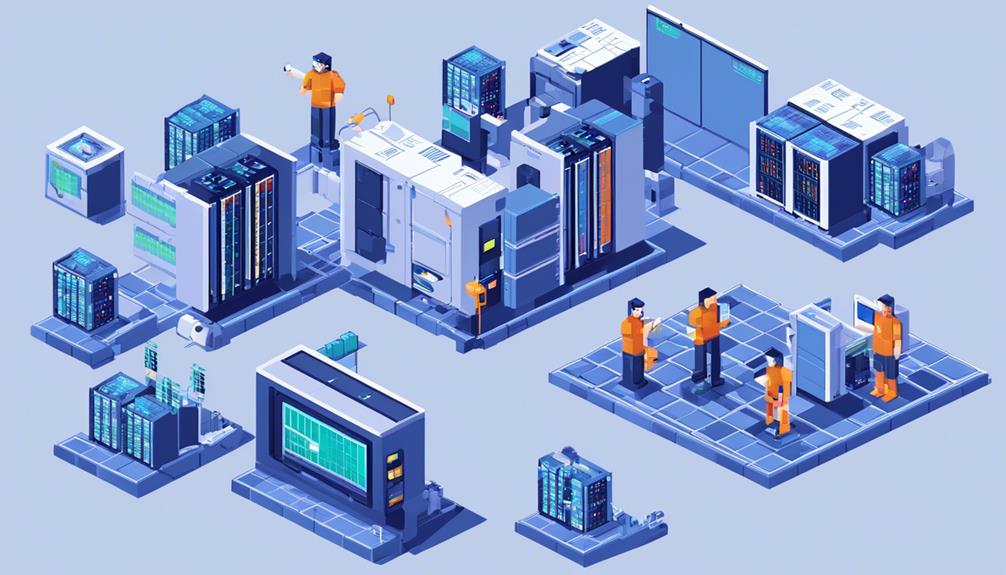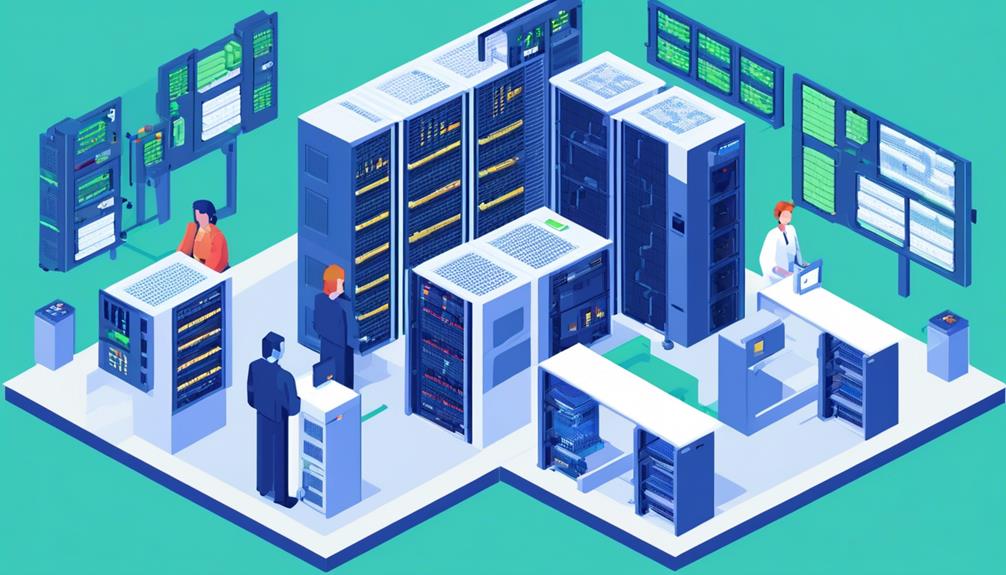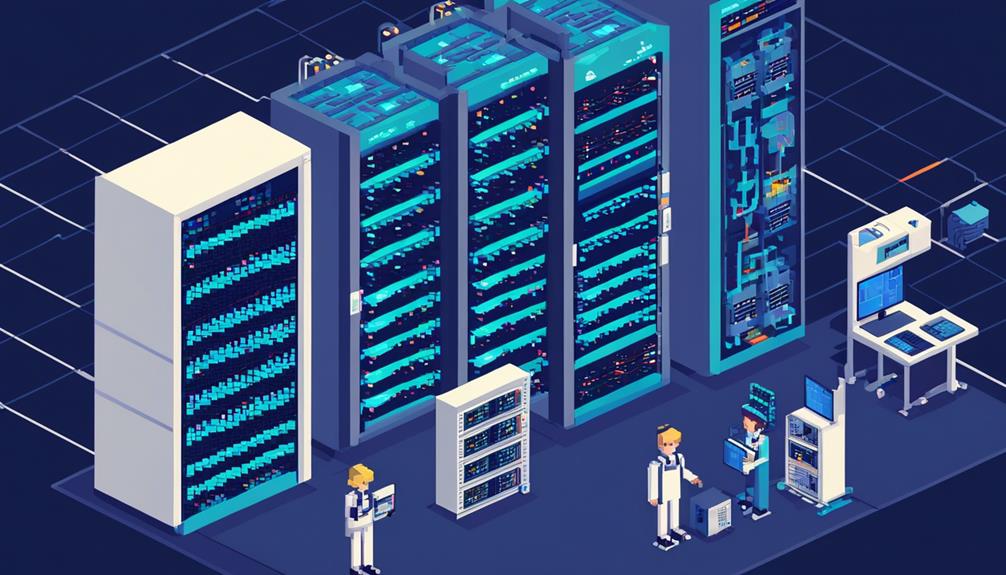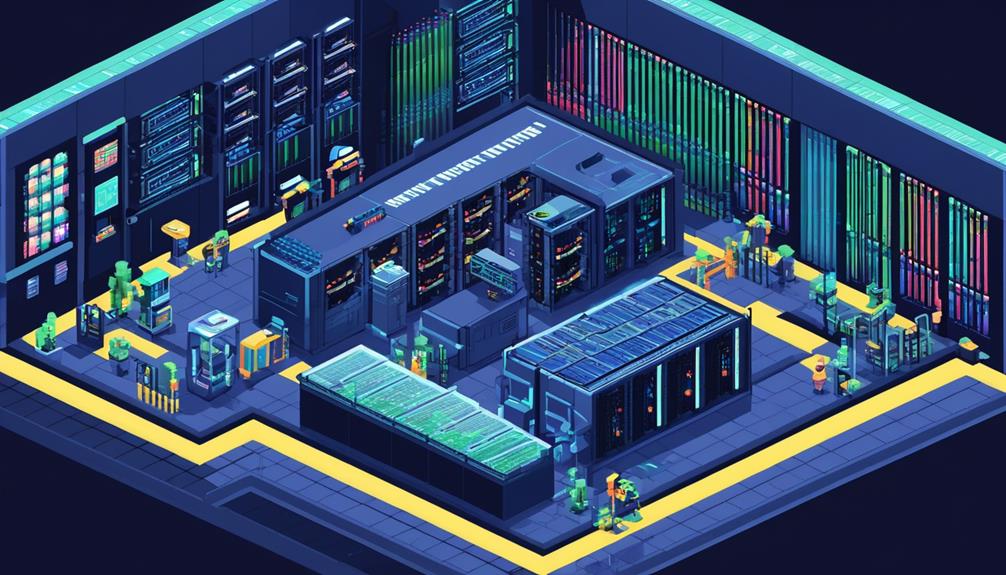As technology continues to advance, the integration of artificial intelligence (AI) in data centers has become increasingly prevalent. One area where AI is making a significant impact is in predictive maintenance.
By harnessing the power of AI algorithms, data centers are able to analyze real-time data from sensors and historical records to detect equipment wear and tear before it leads to failures. The benefits of this AI-powered predictive maintenance approach are numerous, ranging from reduced downtime and cost savings to extended equipment lifespan and improved efficiency.
But what exactly does predictive maintenance with AI entail? How does it optimize data center infrastructure and enhance hardware performance? And what are the future trends in AI-driven data center maintenance?
In this discussion, we will explore these questions and delve into the exciting possibilities that AI brings to the realm of data center maintenance and operations.
Key Takeaways
- AI-powered predictive maintenance in data centers offers numerous benefits, including optimization of power usage, enhanced digital security, automated data management, improved scalability and flexibility, cost-saving benefits, increased reliability, and minimized downtime.
- Predictive maintenance with AI can result in cost savings by reducing downtime, extending equipment lifespan, and optimizing maintenance schedules.
- AI-based predictive maintenance also increases reliability by prolonging equipment lifespan, reducing unnecessary maintenance, and enhancing system reliability and performance.
- Minimizing downtime is another significant advantage of predictive maintenance with AI, leading to reduced downtime, cost savings, and improved efficiency in data centers. Additionally, AI can play a crucial role in hardware longevity by enabling proactive maintenance, preventing downtime, extending hardware lifespan, optimizing hardware utilization, and improving energy efficiency and durability.
Benefits of AI in Data Centers

The implementation of AI in data centers offers a multitude of benefits. These benefits include optimization of power usage, predictive maintenance, enhanced digital security, automated data management, and improved scalability and flexibility.
One significant advantage of utilizing AI in data centers is the ability to implement predictive maintenance strategies. Traditional maintenance approaches often rely on fixed schedules or reactive measures, resulting in unnecessary costs and potential equipment failure. With AI and machine learning algorithms, data centers can now employ predictive maintenance, which uses historical data and real-time monitoring to identify potential issues before they occur. By analyzing patterns and trends, AI can detect anomalies and predict equipment failures, allowing for proactive maintenance and increased equipment lifespan.
Another benefit of AI in data centers is enhanced digital security. As data centers store and process sensitive information, protecting against cyber threats is crucial. AI enables real-time monitoring of network traffic, data access, and user behavior, allowing for anomaly detection and proactive security measures. By continuously analyzing data and identifying abnormal patterns, AI can detect potential security breaches and respond immediately, mitigating risks and ensuring data integrity.
Moreover, the implementation of AI in data centers automates and optimizes data management tasks. AI can efficiently categorize and tag data, improving data organization and accessibility. Additionally, AI enables proactive optimization strategies by analyzing data usage patterns and predicting future demands. This allows data centers to optimize resource management, allocate computing power efficiently, and respond effectively to workload patterns.
Lastly, AI enhances scalability and flexibility in data centers. By analyzing historical data and predicting future demands, AI can optimize resource allocation and scale computing power as needed. This flexibility allows data centers to respond quickly to changing workloads, ensuring optimal performance and reducing costs associated with over-provisioning.
Importance of Predictive Maintenance
Predictive maintenance plays a crucial role in data centers by offering cost-saving benefits, increased reliability, and minimizing downtime.
By proactively identifying potential issues and addressing them before they cause failures, predictive maintenance helps to reduce the overall maintenance costs and increase the lifespan of critical equipment.
This approach also improves the reliability of data center operations, as it allows for timely interventions and prevents unexpected downtime, ensuring smooth and uninterrupted services for clients.
Cost-Saving Benefits
By implementing predictive maintenance strategies, data center operators can achieve significant cost savings through optimized equipment replacement and increased availability. The use of AI in predictive maintenance enables operators to make informed decisions about when to replace equipment, preventing failures and minimizing downtime.
Here are three key cost-saving benefits of predictive maintenance in data centers:
- Reduced downtime: Predictive maintenance helps identify potential equipment failures before they occur, allowing for timely repairs or replacements. This minimizes unplanned downtime, which can be costly for data center operators and their clients.
- Extended equipment lifespan: By regularly monitoring and maintaining critical equipment based on AI-driven algorithms, operators can maximize the lifespan of their assets. This reduces the need for frequent replacements, resulting in long-term cost savings.
- Optimized maintenance schedules: AI analyzes environmental conditions, historical data, and real-time monitoring to optimize maintenance and update schedules. This ensures that maintenance activities are performed at the most efficient times, avoiding unnecessary disruptions and reducing costs.
Increased Reliability
Implementing predictive maintenance strategies in data centers is crucial for ensuring increased reliability and minimizing the risk of equipment breakdowns or performance reductions. By leveraging AI technology, data centers can optimize maintenance schedules and improve overall system efficiency. AI collects data from systems and sensors to identify potential breakdowns or reductions in performance, allowing for proactive maintenance actions to be taken. This predictive approach increases the lifespan of critical equipment and resources, reducing unnecessary and costly maintenance. AI also enhances automation and efficiency, creating more reliable systems. The table below highlights the benefits of predictive maintenance in data centers:
| Benefits of Predictive Maintenance in Data Centers |
|---|
| Increases equipment lifespan |
| Reduces unnecessary maintenance |
| Enhances system reliability and performance |
Minimizing Downtime
To ensure uninterrupted data center operations and maximize uptime, the implementation of predictive maintenance strategies is of paramount importance. By utilizing AI and machine learning algorithms, data centers can minimize downtime and improve overall availability.
Here are three key benefits of predictive maintenance in data centers:
- Reduced Downtime: Predictive maintenance enables proactive identification of potential failures, allowing data center operators to address issues before they cause downtime. This results in increased reliability and uninterrupted operations.
- Cost Savings: By replacing equipment just before failure, predictive maintenance helps avoid costly emergency repairs and unplanned downtime. This proactive approach optimizes maintenance schedules, leading to significant cost savings.
- Improved Efficiency: AI algorithms optimize the distribution of computing resources based on real-time metrics and historical data. This ensures efficient resource allocation, maximizes performance, and minimizes the risk of downtime.
Incorporating predictive maintenance with AI in data centers not only minimizes downtime but also enhances reliability, reduces costs, and improves overall operational efficiency.
Role of AI in Hardware Longevity
AI plays a crucial role in enhancing the longevity of hardware in data centers through machine learning techniques.
By analyzing data patterns and predicting potential hardware issues, AI algorithms enable proactive maintenance, preventing downtime and extending the lifespan of the hardware.
Furthermore, AI can optimize hardware utilization, cooling systems, and resource allocation, leading to improved energy efficiency and durability.
AI's Impact on Lifespan
Utilizing advanced artificial intelligence technologies, data centers are able to optimize hardware maintenance schedules and significantly extend the lifespan of critical equipment. Here is how AI's impact on lifespan plays a crucial role in data centers:
Predictive maintenance: AI and machine learning algorithms anticipate hardware issues, allowing data centers to proactively address them before they lead to downtime. This proactive approach improves overall hardware longevity.
Improved resource allocation: AI enhances data center operations by optimizing resource allocation. By analyzing data and patterns, AI can allocate resources efficiently, reducing strain on hardware and prolonging its lifespan.
Energy efficiency: AI helps data centers streamline procedures and enhance energy efficiency. By identifying areas for improvement and implementing energy-saving measures, AI contributes to extending the lifespan of critical hardware.
AI's impact on lifespan is evident in data centers, where predictive maintenance, resource allocation, and energy efficiency are all optimized to ensure hardware longevity.
Longevity Through Machine Learning
Harnessing the power of machine learning, data centers are able to optimize hardware maintenance schedules and significantly extend the lifespan of critical equipment. Through predictive maintenance, AI and machine learning algorithms can anticipate hardware issues and prevent downtime.
By analyzing historical data, these algorithms can identify patterns and trends that indicate potential failures, allowing for proactive maintenance. This approach not only reduces the risk of unexpected hardware failures but also minimizes the need for reactive repairs, which can be costly and disruptive.
Additionally, AI and machine learning can optimize cooling systems and server utilization, improving energy efficiency and maximizing power usage effectiveness (PUE). By distributing workloads and optimizing resource allocation, these technologies can also enhance system performance and ensure efficient utilization of hardware.
Enhancing Hardware Durability
Enhancing hardware durability through the utilization of advanced artificial intelligence techniques allows for improved longevity and reliability of critical equipment in data centers. AI plays a crucial role in maintaining the integrity of hardware components, ensuring optimal performance and reducing the risk of failure.
Here are three key ways AI enhances hardware durability in data centers:
- Real-time analysis: AI analyzes real-time data to identify trends and patterns in hardware usage and performance. By detecting anomalies and predicting potential issues, AI helps prevent hardware failures and extends the lifespan of critical equipment.
- Optimized maintenance schedules: AI optimizes hardware maintenance schedules based on environmental conditions and historical data. By scheduling maintenance activities at the most opportune times, AI minimizes downtime and increases the longevity of hardware.
- Cost-effective maintenance: AI reduces unnecessary and costly hardware maintenance for data centers. By accurately predicting maintenance requirements and prioritizing tasks, AI eliminates unnecessary expenses while ensuring the reliability and durability of hardware.
Optimizing Data Center Infrastructure With AI
AI plays a pivotal role in optimizing data center infrastructure, improving efficiency, scalability, and security. With the help of AI technology, data centers can achieve significant advancements in their operations and performance.
One area where AI proves valuable is in predictive maintenance. By utilizing AI algorithms, data centers can identify early signs of equipment wear and tear, enabling proactive maintenance to reduce downtime and improve overall efficiency.
Furthermore, AI algorithms can monitor and predict daily workload patterns, allowing data centers to adjust their infrastructure as needed. This capability enhances scalability and flexibility, ensuring that the data center can effectively handle varying workloads and demands. AI's ability to analyze large datasets and identify patterns also enables automation and streamlining of day-to-day operations in data centers.
In terms of infrastructure optimization, AI offers significant benefits in power usage. By analyzing data and making intelligent decisions, AI can optimize power consumption, reducing energy waste and lowering the environmental impact of data centers. This not only leads to cost savings but also aligns with sustainability goals.
Additionally, AI contributes to enhancing data center security. AI algorithms can detect anomalies in network traffic, access logs, and system behavior, enabling the identification of potential security threats. Features like facial recognition and biometric scans can also be integrated with AI technology to further enhance digital security within data centers.
Enhancing Hardware Performance With AI

Utilizing advanced algorithms and real-time data analysis, hardware performance in data centers can be significantly improved through the integration of AI technology. By harnessing the power of AI, predictive maintenance can be implemented to detect potential breakdowns or reductions in performance, optimizing maintenance schedules based on environmental conditions, historical data, and real-time monitoring.
Here's how AI enhances hardware performance in data centers:
- Optimized Power Usage: AI analyzes real-time data to allocate resources effectively, improving data center cooling, power distribution, and workload management. This optimization reduces energy waste, lowering the environmental impact of data centers. Machine learning algorithms anticipate future energy demands and adjust operations accordingly.
- Enhanced Digital Security: AI plays a crucial role in ensuring the security of hardware in data centers. By monitoring and analyzing massive amounts of data in real-time, AI can detect suspicious activities or abnormalities. Automated responses can be triggered to isolate compromised systems and alert security personnel in real-time, thus minimizing the potential impact of security breaches.
- Efficient Resource Distribution: AI optimizes the distribution of computing resources in data centers by leveraging real-time metrics and historical data. This optimization improves scalability by allocating resources more efficiently, ensuring that workloads are balanced across the infrastructure. Additionally, AI monitors and predicts daily workload patterns, allowing for adjustments to the infrastructure as needed.
AI-Driven Maintenance Strategies
AI-driven maintenance strategies leverage real-time data analysis to optimize power usage, reduce energy waste, and lower the environmental impact in data centers. Predictive maintenance, powered by AI, is a key component of these strategies. It optimizes equipment maintenance schedules, increases the lifespan of critical assets, and reduces unnecessary costs for data center operations.
One of the main benefits of AI-driven maintenance strategies is the ability to predict and prevent equipment failures before they occur. By utilizing machine learning models, data centers can analyze historical data, identify patterns, and detect early signs of potential issues. This allows for proactive maintenance, minimizing downtime and maximizing operational efficiency.
Furthermore, AI enhances digital security in data centers. By monitoring and analyzing data, AI can detect suspicious activity, automate responses, and improve overall security measures. This proactive approach helps in preventing cyber-attacks and safeguarding sensitive information.
In addition to maintenance and security, AI also improves data management tasks in data centers. It automates and optimizes processes, supports analytics, and enables a predictive approach. By leveraging AI, data centers can efficiently manage their vast amounts of data, ensuring its availability, reliability, and accuracy.
Moreover, AI optimizes resource management in data centers. It enables scalability and dynamic infrastructure adjustments to meet shifting workloads and demand increases. AI-driven strategies help data centers efficiently allocate resources, ensuring optimal performance and reducing unnecessary energy consumption.
Predictive Maintenance Techniques

Predictive maintenance techniques leverage advanced data analysis to proactively identify potential equipment failures and optimize maintenance schedules in data centers. By using AI algorithms, these techniques analyze data collected from systems and sensors to detect any signs of breakdowns or reductions in performance. This allows data center operators to take preventive measures before any critical failures occur, ensuring smooth operations and minimizing downtime.
To draw the audience in and keep them interested, here are three key aspects of predictive maintenance techniques:
- Workload Management: Predictive maintenance techniques help in managing the workload of data center infrastructure. By analyzing historical data and real-time monitoring, AI can identify patterns and trends that indicate potential issues. This enables operators to distribute workloads effectively, preventing overloads that can lead to equipment failures.
- Optimal Maintenance Schedules: AI optimizes maintenance and update schedules based on factors such as environmental conditions and historical data. By considering these variables, data center operators can schedule maintenance activities at the most convenient times, minimizing disruptions to operations while ensuring that critical equipment remains in optimal condition.
- Cost Reduction: Predictive maintenance techniques reduce unnecessary and costly maintenance for both cloud and traditional data centers. By accurately predicting equipment failures, operators can avoid unnecessary maintenance activities, saving both time and resources. Additionally, by identifying potential issues early on, operators can address them before they escalate, preventing costly breakdowns and repairs.
AI-Enabled Fault Detection and Diagnosis
AI-Enabled Fault Detection and Diagnosis employs real-time data analysis to identify potential equipment breakdowns or performance reductions in data centers. By leveraging the power of AI, data center operators can optimize maintenance and update schedules based on historical data, environmental conditions, and real-time monitoring. This approach not only enhances the efficiency of data center operations but also increases the lifespan of critical equipment and resources.
Through machine learning algorithms, AI can anticipate future energy demands, adjust operations, and allocate resources effectively. This capability improves data center cooling, power distribution, and workload management. By accurately predicting and addressing potential issues, AI reduces unnecessary and costly maintenance for both cloud and traditional data centers, leading to overall savings for data center operators and their clients.
Moreover, AI and machine learning enable the automation of responses to isolate compromised systems, apply corrective actions, and alert security teams in real-time. This capability enhances digital security by rapidly detecting and mitigating potential threats.
The use of AI in fault detection and diagnosis not only improves the reliability and performance of data center equipment but also ensures the smooth operation of critical systems. By continuously analyzing real-time data, AI can detect anomalies and deviations from normal operating conditions, enabling proactive maintenance and minimizing the risk of unexpected failures.
AI in Preventive Maintenance

AI in preventive maintenance plays a critical role in data centers by enabling fault detection and automated maintenance scheduling.
By utilizing real-time data and machine learning algorithms, AI systems can identify potential issues before they lead to breakdowns or performance reductions.
This allows for optimized maintenance and update schedules based on historical data and real-time monitoring, ultimately improving equipment reliability and reducing unnecessary maintenance costs.
Ai-Enabled Fault Detection
The implementation of advanced technology for fault detection in preventive maintenance has revolutionized the efficiency and reliability of data centers. AI-enabled fault detection systems have proven to be invaluable in predicting and preventing equipment failures, minimizing downtime, and optimizing maintenance schedules.
Here are three key ways in which AI is transforming fault detection in data centers:
- Real-time monitoring: AI analyzes real-time data from systems and sensors to detect anomalies and deviations from normal operating conditions, allowing for prompt identification and resolution of potential faults.
- Predictive analytics: By analyzing historical data and patterns, AI can anticipate potential breakdowns or performance reductions, enabling proactive maintenance and reducing the risk of unexpected failures.
- Automated alerts and notifications: AI systems can automatically send alerts and notifications to operators and maintenance teams when abnormal conditions or potential faults are detected, ensuring timely intervention and preventing further damage.
With AI-enabled fault detection, data centers can proactively address issues before they escalate, ensuring uninterrupted operations and maximizing equipment lifespan.
Automated Maintenance Scheduling
The integration of AI in preventative maintenance further enhances the efficiency and reliability of data centers. By introducing automated maintenance scheduling based on real-time monitoring and historical data analysis, AI algorithms optimize maintenance schedules. This ensures that critical equipment is serviced at the right time to prevent failures and minimize downtime.
With real-time monitoring, AI systems continuously collect data on the performance and health of equipment. This allows for proactive maintenance actions to be taken. Additionally, historical data analysis helps identify patterns and trends. This enables AI to predict when maintenance should be performed based on past performance.
This predictive approach to maintenance reduces the risk of unexpected failures, extends the lifespan of equipment, and reduces unnecessary and costly maintenance tasks. Ultimately, automated maintenance scheduling with AI enables data center operators to move beyond reactive measures. They can adopt a more proactive and efficient approach to maintenance.
Predictive Analytics for Data Center Hardware
Predictive Analytics for Data Center Hardware enables proactive maintenance and optimization through the analysis of real-time data and identification of trends and patterns in power usage. By leveraging AI algorithms and machine learning, data centers can improve cooling, power distribution, and workload management.
Here are three key ways predictive analytics benefits data center hardware:
- Enhanced Energy Efficiency:
AI algorithms analyze real-time data to anticipate future energy demands and adjust operations accordingly. By optimizing power usage, data centers can achieve significant cost savings and reduce their environmental footprint. Predictive analytics enables intelligent resource allocation, ensuring that computing resources are distributed efficiently based on real-time metrics and historical data.
- Predictive Maintenance:
Powered by AI, predictive maintenance collects data from systems and sensors to identify potential breakdowns or reductions in performance. By analyzing this data, data center operators can optimize maintenance and update schedules, reducing unnecessary and costly downtime. This proactive approach increases the lifespan of critical equipment, improving overall operational efficiency.
- Improved Scalability:
AI and predictive analytics enable data centers to scale their operations more effectively. By analyzing real-time data on workload, power usage, and resource allocation, data centers can optimize the distribution of computing resources. This ensures that resources are allocated efficiently, minimizing waste and maximizing performance. As a result, data centers can meet increasing demands without compromising on efficiency or reliability.
AI-Enhanced Monitoring and Alert Systems

AI-Enhanced Monitoring and Alert Systems revolutionize data center operations by utilizing real-time data analysis to detect potential hardware issues and prevent costly downtime. These systems optimize resource allocation, workload management, and capacity planning through machine learning algorithms. By continuously monitoring data center infrastructure, these systems can detect anomalies and patterns that may indicate potential hardware failures. This enables data center administrators to take proactive measures and address issues before they escalate into critical failures.
One of the key advantages of AI-enhanced monitoring and alert systems is their ability to improve security in data centers. By analyzing real-time data, these systems can identify anomalies and potential attacks, enabling administrators to respond quickly and effectively. This helps in safeguarding sensitive data and preventing unauthorized access to the data center.
Furthermore, these systems automate and improve management functions, cutting expenses and increasing operational effectiveness. Through predictive maintenance capabilities, AI-enhanced monitoring systems can predict the lifespan of critical components and schedule maintenance activities accordingly. This helps in reducing downtime and optimizing the lifespan of hardware, resulting in cost savings for data center operators.
As AI and machine learning technologies continue to evolve, these monitoring and alert systems will integrate with edge computing to optimize resource allocation. This will enable data centers to efficiently allocate resources based on real-time demand, ensuring optimal performance and reducing wastage.
Data Center Efficiency Through AI
With the advancements in AI and machine learning technologies, data centers are experiencing improved efficiency and optimization through the integration of AI into their operations. The use of AI in data centers enables predictive maintenance, optimizes power usage, enhances digital security, automates data management tasks, and optimizes the distribution of computing resources. This leads to increased efficiency and reduced costs for data center operators.
Predictive Maintenance: AI-powered predictive maintenance collects and analyzes data to identify potential breakdowns in critical equipment. By detecting early signs of failure, data center operators can schedule maintenance activities in advance, minimizing downtime and increasing the lifespan of equipment. This proactive approach reduces the risk of unplanned outages and improves the overall efficiency of the data center.
Power Usage Optimization: AI optimizes power usage by analyzing real-time data and identifying opportunities for energy conservation. By monitoring and adjusting power consumption based on workload demands, data centers can reduce energy waste and lower their environmental impact. This not only improves efficiency but also helps organizations achieve their sustainability goals.
Resource Distribution Optimization: AI optimizes the distribution of computing resources within data centers. By analyzing workload patterns and dynamically allocating resources, AI enables data centers to operate at maximum efficiency. This leads to improved scalability, as resources can be allocated more efficiently to meet changing demands. Additionally, dynamic resource management allows for better utilization of resources, reducing costs and increasing flexibility.
Cost Savings With Predictive Maintenance

Implementing predictive maintenance in data centers can lead to significant cost savings and improved operational efficiency. By using AI and machine learning algorithms, data centers can identify potential breakdowns or reductions in performance, enabling timely maintenance and reducing unnecessary and costly repairs. This proactive approach not only saves money but also minimizes downtime and improves the overall reliability of the systems.
One area where cost savings are realized is in energy usage. AI can analyze historical data, anticipate future energy demands, and optimize power usage accordingly. By adjusting operations and reducing energy waste, data centers can lower their environmental impact and save costs associated with excessive energy consumption.
Predictive maintenance also extends the lifespan of critical equipment and resources, reducing downtime and hardware replacement costs. By continuously monitoring the health of assets and identifying potential issues in advance, data centers can plan maintenance activities more efficiently, preventing emergency repairs and minimizing the impact on revenue.
Furthermore, AI can optimize maintenance and update schedules based on real-time monitoring and environmental conditions. By considering factors such as workload, temperature, and humidity, data centers can prioritize maintenance tasks and allocate resources effectively, reducing unnecessary expenses.
Additionally, AI can optimize the distribution of computing resources based on real-time metrics and historical data. This improves scalability and enables data centers to handle sudden demand increases and shifts in workloads without compromising performance or incurring additional costs.
Future Trends in AI-Driven Data Center Maintenance
The future of data center maintenance is set to be revolutionized by advancements in AI and machine learning technologies. As data centers become more complex and handle larger workloads, predictive maintenance powered by AI will play a crucial role in ensuring optimal performance and minimizing downtime.
Here are three future trends in AI-driven data center maintenance:
- Advanced Automation: AI and ML technologies will further automate data center tasks, increasing efficiency and reducing the need for manual intervention. This will enable data center operators to focus on more strategic initiatives while routine maintenance tasks are handled by intelligent systems.
- Enhanced Predictive Capabilities: AI and ML algorithms will become more sophisticated in predicting hardware issues before they occur. By analyzing vast amounts of data, including historical performance data, environmental conditions, and real-time sensor data, these algorithms can identify patterns and indicators of potential failures. This proactive approach enables data center operators to address issues before they escalate, minimizing the impact on operations.
- Integration with Edge Computing: As edge computing continues to gain momentum, AI and ML will be integrated with edge devices to optimize resource allocation. By leveraging real-time data and AI algorithms at the edge, data center operators can make intelligent decisions on workload placement, storage, and processing, ensuring efficient use of resources and reducing latency.
With increased adoption of AI and ML solutions in data centers, CIOs and data center operators can expect improved operational efficiency, reduced downtime, and cost savings. The continuous learning capabilities of AI algorithms will enable them to adapt to shifting workload patterns and evolving hardware technologies. As a result, data centers will be better equipped to handle the demands of the future and ensure smooth and reliable operations.
Frequently Asked Questions
Can AI Do Predictive MAIntenance?
Yes, AI has the capability to perform predictive maintenance. By analyzing real-time data and identifying trends and patterns, AI can predict potential breakdowns or performance reductions in various industries, including manufacturing.
However, implementing AI for predictive maintenance comes with challenges such as data quality and integration.
Machine learning plays a crucial role in predictive maintenance by training models to recognize anomalies and predict failures.
Several case studies have demonstrated the success of AI in predictive maintenance, showcasing its ability to improve operational efficiency and reduce downtime.
How Is AI Used in Data Centers?
AI is extensively used in data centers for various purposes. It plays a crucial role in facility management by optimizing resource allocation, improving scalability, and enabling dynamic workload management.
Additionally, AI enhances energy efficiency by analyzing real-time data to identify trends and patterns, reducing energy waste. It also helps in implementing robust security measures through real-time monitoring, adaptive threat detection, and automated responses.
How to Use AI in MAIntenance Management?
AI algorithms have revolutionized maintenance management by offering numerous benefits. These include improved efficiency, reduced downtime, and increased cost savings.
By analyzing real-time data and historical patterns, AI can predict potential issues and schedule maintenance tasks accordingly. However, implementing AI in maintenance management comes with challenges, such as data quality and integration with existing systems.
Real-life examples of AI in maintenance include predictive maintenance in manufacturing plants and condition-based monitoring in transportation fleets.
How Predictive MAIntenance an Application of AI Prevents Unplanned Downtime?
Predictive maintenance is an application of AI that effectively prevents unplanned downtime in data centers. By leveraging real-time data and historical patterns, AI can identify potential breakdowns or reductions in performance before they occur. This allows for proactive maintenance scheduling and reduces the risk of unexpected outages.
Several case studies have demonstrated the benefits of AI in predictive maintenance, including improved operational efficiency, cost savings, and increased equipment lifespan. However, implementing AI-based predictive maintenance in data centers comes with challenges such as data quality, integration complexity, and the need for skilled personnel.
Advancements in AI, including machine learning and automation, offer promising future trends for further enhancing predictive maintenance capabilities in data centers.

